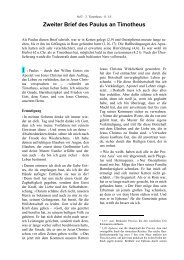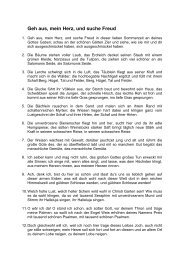Create successful ePaper yourself
Turn your PDF publications into a flip-book with our unique Google optimized e-Paper software.
➨<br />
➨<br />
➨<br />
not mean that we can see colours – it only provides<br />
the necessary preconditions.<br />
The sensation of colour only arises in the brain<br />
after a computational comparison of the excitation<br />
of the three types of cones. There are about<br />
100 million optic cells in the retina, but only one<br />
million optic nerve fibres lead from them. This<br />
means that many optic cells are interconnected in<br />
a complex fashion. The optic nerve transmits<br />
image information to various parts of the brain in<br />
the form of electrical pulses. A small number of<br />
fibres lead directly to the mid-brain, but most of<br />
them converge on a switchboard which serves the<br />
primary vision centre in the rear of the brain.<br />
The images formed on both retinas are upside<br />
down and also left-right inverted. But an<br />
astounding fact is that the optic nerves from<br />
both eyes split up and cross each other in<br />
such a way that the left halves of the<br />
images of both eyes are received by the<br />
right half of the brain, and the right<br />
halves end up in the left hemisphere of<br />
the brain. Each half of the observer’s brain<br />
receives information from only one half of the<br />
image. In addition, these images are distorted,<br />
because the region around the yellow spot (the<br />
fovea – where we see best; the Latin word for a<br />
hollow) forms an image which is ten times as<br />
large as that of the peripheral area. The left side<br />
of the brain only observes the left half of the<br />
image ( = the right half of what we are looking<br />
at) and this half is the right way up with the distortion<br />
removed. At the same time the right side<br />
of the brain deals with the other half of the field<br />
of view.<br />
Note that, although the brain processes the different<br />
parts of the image in various remote locations,<br />
the two halves of the field of vision<br />
are seamlessly re-united, without any trace of<br />
a joint – amazing! This process is still far from<br />
being fully understood.<br />
Hermann von Helmholtz (1821 – 1894), a famous<br />
physicist and physiologist of the 19th century,<br />
comparing the error count of eye imaging with<br />
that of a lens, concluded as follows in 1863:<br />
<br />
<br />
Structure of the retina<br />
Rods<br />
Horizontal cells<br />
Bipolar cells<br />
Amacrine cells<br />
<br />
<br />
<br />
<br />
<br />
<br />
Ganglia<br />
(singular = ganglion)<br />
Direction of incident<br />
light<br />
Glial (supporting) cells<br />
Cones<br />
“If an optician sold me an instrument having the<br />
errors exhibited by the eye, it would be in order<br />
for me to express my dissatisfaction with the<br />
quality of his work in the strongest terms, and<br />
return his instrument forthwith.”<br />
Helmholtz was wrong, since he only measured<br />
the performance of the lens of the eye in comparison<br />
with the light path in optical instruments.<br />
But he forgot that no technologically produced<br />
lens system can function faultlessly for the<br />
length of a human lifespan. Neither is it protected<br />
against heat and cold, dryness and humidity,<br />
shocks and dust, nor can it repair itself in the<br />
event of minor damage. Which optical instrument<br />
available at that time could adjust itself auto-<br />
17
















